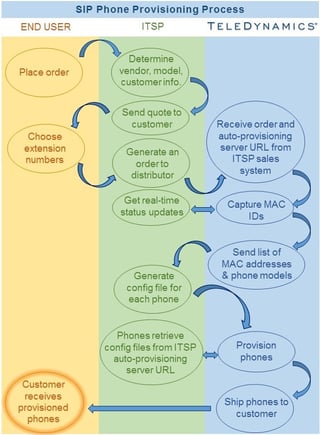
OK, so maybe provisioning SIP phones was never a barrel of laughs. But it can at least be quick, easy and painless. And that definitely leaves more time for fun.
Unlike dialog phones, phones that work on SIP (Session Initiated Protocol) don’t do anything when they’re plugged in, until they are properly programmed. Programming a SIP phone is known as provisioning. There are a number of reasons why it could make sense to let TeleDynamics handle this for you when ordering your SIP phones. We guarantee an out-of-the-box experience for your customer and can even include your literature in the box so it looks like the equipment is coming from your own warehouse.
There are five main types of provisioning:
- Manual provisioning: Each phone is provisioned manually, either using the phone’s buttons or the WebGUI.
- DHCP option provisioning: Each phone is provisioned via a configuration (config) file, the transfer of which is controlled locally using a TFTP server.
- Zero touch provisioning: The manufacturer allows the phones to point to a local TFTP server to retrieve the config files, without using a local DCHP (Dynamic Host Configuration Protocol).
- Redirect provisioning server: The manufacturer allows the phones by default to point to an HTTP server that you control to “redirect” to another off-site server to retrieve the config files.
- Distributor partners auto-provisioning: The distributor embeds a blend of protocols with their in-house software to remotely set up IP phones without using a WebGUI or phone handset buttons. This allows server-to-server sharing of MAC (media access control) addresses and serial numbers between the distributor and the Internet telephony service provider (ITSP).
TeleDynamics uses the auto-provisioning option (number 5 above), of which we provide two types, depending on customer preference.
- Full provisioning: We make sure the phones come up with an extension and test while they are still in our warehouse.
- Partial provisioning: We pre-load the phones with all the needed configurations, but ship them out before the dealer has registered the MAC identifiers with the hosted network on which the phones will be registered. In this case, the phones typically register at the end-user location upon their first boot up, once the MAC addresses are registered with the ITSP.
 The flow chart shows how the process works. The exchange of MAC addresses and configuration files all happens between the servers, so virtually no human intervention is needed if the process is also automated on the part of the ITSP. Depending on how long it takes to confirm the MAC IDs, it could take as little as 5-10 minutes per phone from start to finish.
The flow chart shows how the process works. The exchange of MAC addresses and configuration files all happens between the servers, so virtually no human intervention is needed if the process is also automated on the part of the ITSP. Depending on how long it takes to confirm the MAC IDs, it could take as little as 5-10 minutes per phone from start to finish.The main advantages of outsourcing the provisioning to TeleDynamics include:
- Guaranteed out-of-the-box experience: Your customer simply plugs in the equipment and makes a call! Takes out the hassle and saves a lot of time.
- Greater accuracy: Computer-based provisioning minimizes the risk of human error.
- Equipment verification: The provisioning process allows us to detect any DOA (dead-on-arrival) hardware, so you don’t run the risk of having defective equipment delivered to the customer.
- Fast turn-around time and same-day shipping: This ensures that no time will be lost in getting the system up and running.
- Enhancement of your brand: We can provide fulfillment services like including your literature in the box and your branding on the shipping label, so it looks like the equipment comes directly from you.
CONCLUSION
Ask your TeleDynamics representative about provisioning your next order of SIP phones. Then have some fun thinking of ways to spend the extra time you just freed up!










Comments